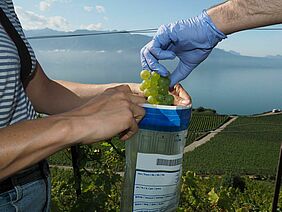In five small organic vineyards up to 0.25 ha in Switzerland, we took samples of leaves, fruit and wine and analysed them for pesticide residues. Leaf samples were taken in July 2021 during the peak spraying time. Fruit samples were taken in September during the pre-harvest interval, when spraying is not allowed any more. White wines made from the studied vineyards were analysed in the following spring. All samples were analysed with a multi-residue screening plus a single method detecting fosetyl and phosphonic acid.
A total of 16 different pesticides, all of which are fungicides or fungicide metabolites, were detected. In the leaf samples of the first row, 6.4 substances per sample were detected on average. For the pesticides detected with the screening, residue levels in leaves were much higher than in fruit (by a factor of 25 – 50), while levels in fruit and wine were similar. In the leaf samples, residues in the first row were much higher than in the second row (by a factor of 5).
Phosphonic acid detected in all samples
For fosetyl, the frequency of detection decreased strongly from leaves to fruit and from fruit to wine. By contrast, phosphonic acid was detected in all samples (leaves, fruit and wine alike). For phosphonic acid, residue levels in leaves were higher than in fruit (by a factor of 2 – 3), while levels in fruit and wine were similar, and there was no major difference in residue levels in leaf samples from different rows.
The pattern of residues suggests that drift is the most likely cause for the detection of pesticides from the screening. The residues of phosphonic acid reflect the unique behaviour of this substance which is stored in the wood during wintertime and relocated to the leaves and fruit during the vegetation period. When considering the pesticide screening, two out of the four wines exceeded the current 'intervention value' for organic products.
For phosphonic acid in unprocessed organic food, an intervention value of 0,05 milligram per kilogram is in force since April 2023. Experience shows that the levels of phosphonic acid in grapes and in wine are similar. All four wines exceeded this intervention value. Organic winegrowers have limited options for reducing the risks of pesticide drift. This is particularly true for phosphonic acid, where the causes of residues are still poorly understood.
This article was published in the open access publication Swiss Agricultural Research in August 2023.
Further information
Contact
- Bernhard Speiser
- Mirjam Schleiffer
Link
agrarforschungschweiz.ch: Article in Swiss Agricultural Research




